|
|
|
Sort Order |
|
|
|
Items / Page
|
|
|
|
|
|
|
| Srl | Item |
| 1 |
ID:
087465
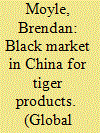

|
|
|
|
|
| Publication |
2009.
|
| Summary/Abstract |
Poaching of tigers is a major threat to the survival of the species. China is responsible for much of the demand for tiger parts. Poaching occurs because it is profitable and organizations able to procure transport and sell tiger products over thousands of miles and international borders also exist. Unfortunately there is little corresponding data on these organizations. It appears as if these organizations operate to minimize the most significant transaction cost along the supply chain. Tigers are a minority element in a portfolio of wildlife products assembled by smugglers in range states. Within China smugglers specialize in the skins and bones of tigers, and are most likely to operate in small, discrete groups. This is a function of the high coordination and evasion costs of operating in China. The demand for tiger parts has strong cultural and medicinal influences.
|
|
|
|
|
|
|
|
|
|
|
|
|
|
|
|
| 2 |
ID:
087463
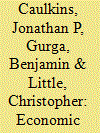

|
|
|
|
|
| Publication |
2009.
|
| Summary/Abstract |
The fundamental activity of most drug dealers is buying drugs from a supplier and selling them on, usually in smaller lot sizes to multiple customers at a lower market level. Data on such 'cycles' of purchase and resale are derived from interviews with 65 dealers incarcerated in UK prisons. A power function relationship between price and transaction size is confirmed. Analyses reveal great consistency in proportional price markups across drugs and time, high cycle frequencies (typically weekly or more often) and importers who vertically integrate into the highest level of domestic distribution, so that an important share of their net revenues effectively derives from domestic distribution inside the UK, as opposed to importation per se.
|
|
|
|
|
|
|
|
|
|
|
|
|
|
|
|
| 3 |
ID:
087466
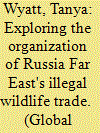

|
|
|
|
|
| Publication |
2009.
|
| Summary/Abstract |
The Russian Federation is a source of wildlife and wildlife products that fuel the vast, and often overlooked, illegal wildlife trade that takes place around the globe. Out of the many illicit animal and plant trades, two of these black markets - the illegal fur trade and the illegal falcon trade - are used in this article to explore the organization of this illicit activity in Russia Far East. Using interviews from Russian and other wildlife trade experts, structural frameworks are established for each of these illegal wildlife markets.
|
|
|
|
|
|
|
|
|
|
|
|
|
|
|
|
| 4 |
ID:
087462
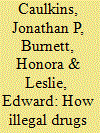

|
|
|
|
|
| Publication |
2009.
|
| Summary/Abstract |
A typology of drug smuggling 'technologies' is developed based on interviews with 110 inmates incarcerated in UK prisons for importing illegal drugs. Approximately three-quarters were involved in courier-based operations. The other 30 collectively accounted for substantially greater smuggling throughput capacity and fell into five groups: operations employing 'bent' lorry drivers; shipping drugs intermingled with legitimate commerce; transporting drugs on commercial airlines with assistance from corrupt officials; mailing drugs into the UK; and smuggling via boats landing between ports of entry. A Pareto Law seems to apply, with a minority of respondents being responsible for the majority of the smuggling. Most participated in smuggling to make money, but more than a few couriers reported being coerced and/or tricked into carrying drugs. Perhaps not coincidentally, rough calculations suggest that, when balancing profits against prison risk, crime does not pay for couriers but can for organizations employing bent lorry drivers.
|
|
|
|
|
|
|
|
|
|
|
|
|
|
|
|
| 5 |
ID:
087456


|
|
|
|
|
| Publication |
2009.
|
| Summary/Abstract |
We highlight how the different studies included in this special issue contribute to our understanding of illegal markets and the economics of organized crime. A focus on the 'economics' of organized crime brings attention to the outcomes (costs and benefits), but also to the process leading to these outcomes, including analyses of the markets where criminal organizations are active.
|
|
|
|
|
|
|
|
|
|
|
|
|
|
|
|
| 6 |
ID:
087464


|
|
|
|
|
| Publication |
2009.
|
| Summary/Abstract |
The market for domestically produced methamphetamine in Australia (sold as 'speed' and 'base') has been recently supplemented with imported crystalline methamphetamine ('ice' or 'crystal'), the supply of which is thought to involve different organized crime groups than those involved with domestic supply. The existence, or otherwise, of distinct retail markets for these different forms of methamphetamine has important implications for police and public health strategies. The aim of this study was to examine whether there was evidence of distinct retail markets for crystalline methamphetamine and domestically produced forms of the drug. A cross-sectional survey of regular methamphetamine users (n = 309) was undertaken in Sydney, Australia to assess the characteristics of the retail market (consumption, price, perceived purity, availability, purchase location and sale from dealers) for crystalline methamphetamine compared with domestically produced forms of the drug (i.e. speed and base). We did not find any clear evidence of a segregated retail market for crystalline methamphetamine. Only 3% of participants were exclusive crystalline methamphetamine users, and both crystalline methamphetamine and other domestically produced forms of the drug were readily available to consumers, being typically purchased from the same dealers, in the same location and at the same price.
|
|
|
|
|
|
|
|
|
|
|
|
|
|
|
|
| 7 |
ID:
087460


|
|
|
|
|
| Publication |
2009.
|
| Summary/Abstract |
It is difficult to measure the size, influence and growth patterns of criminal organizations embedded in illegal markets. In this paper, we argue that measuring the influence of a criminal organization by its size (in number of employees, or 'members') may under- or overestimate its sphere of influence in illegal markets. Self-report survey and size of population methodologies are combined to assess the regional economic influence of a criminal organization (Hells Angels) in three illegal drug markets (the cocaine trade, the cannabis trade and the cannabis cultivation industry) in the province of Qu bec. Findings suggest that a relatively small organization by conventional standards can nonetheless achieve a large influence on criminal markets. We then analyse how factors other than violence play a role in explaining differences in achieving economic influence across criminal organizations. Finally, we suggest that turning our attention to measuring economic influence provides some insights into the duration and intensity of the violent conflicts occurring in these markets.
|
|
|
|
|
|
|
|
|
|
|
|
|
|
|
|
| 8 |
ID:
087461


|
|
|
|
|
| Publication |
2009.
|
| Summary/Abstract |
We develop a theory of optimal networks in the context of criminal organizations. In this framework the criminals choose their network links with others according to a set of specified costs and benefits to participation. The optimal number and configuration of links within each network is solved for a set of 10,000 parameter simulations specifying the direct cost of links between agents, the benefit to connections, and the cost of being in the network with others. In addition, agents determine the size of the optimal network. This framework allows consideration of a variety of crime policy scenarios. In particular, removing the 'key player', the best strategy when the network is exogenous, may not be the optimal strategy in an environment in which the agents can change the size and structure of the network endogenously. More generally, optimal crime policy may be different if the criminals are aware of the policing strategy and can alter their network.
|
|
|
|
|
|
|
|
|
|
|
|
|
|
|
|
| 9 |
ID:
087458
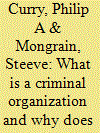

|
|
|
|
|
| Publication |
2009.
|
| Summary/Abstract |
The Criminal Codes in both Canada and the United States allow for criminals to be penalized to a greater degree if they are a member of an organization. We draw on the economic theory of punishment, which states that expected penalty should be proportional to the social harm caused, to put a different perspective on such regulations. According to the economic theory, additional punishments are desirable if either: (1) the social harm from a criminal act is greater for a member of an organization than for an independent criminal; or (2) the probability of conviction is lower. We examine the extent to which both of these possibilities are true and use the findings to revisit the definition of a criminal organization.
|
|
|
|
|
|
|
|
|
|
|
|
|
|
|
|
|
|
|
|
|